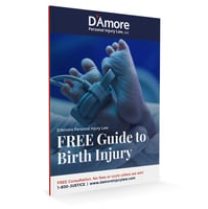D'Amore Personal Injury Law, LLC
Serious Injury Lawyers Proudly Serving
Baltimore, Annapolis, & Washington, D.C.
Shoulder Dystocia
What is Shoulder Dystocia?
What are the warning signs of shoulder dystocia?
- The “turtle sign during labor” - this is when the baby’s head will appear but will retract back into the birth canal, similar to a turtle’s head going in and out of its shell. This is usually paired with the baby having a red, puffy face.
- The baby may be suffering from discomfort or nerve damage in the injured area.
- The baby may have a claw-like hand.
- In more serious cases, the child may also suffer paralysis of the affected limb, known as Erb's palsy.
- A broken collarbone can also be the result of shoulder dystocia.
- And finally, bruising of the affected area.
High risk warning signs of shoulder dystocia during pregnancy
While there is no definitive sign of shoulder dystocia risk, below are the factors which are most commonly identified in pregnant women where a shoulder dystocia occurs during birth.
- Mothers who have had babies with shoulder dystocia before
- Fetal macrosomia
- Mothers with gestational or pre-gestational diabetes
- Mothers who are significantly overweight
Other high risk warning signs
- Mothers with narrow hips or a petite frame
- Mothers with an advanced gestational age
- Multiples (i.e., twins, triplets, etc.)
Learn more about what to do after a Birth Injury in our FREE guide.

F.A.Q.
WHAT SHOULD YOU DO IF YOU HAVE SHOULDER DYSTOCIA RISK FACTORS?
The best bet is to have an obstetrician who is aware of your risk factors and who has a safe plan for delivery that takes them into consideration. Speaking to your doctor about the warning signs of shoulder dystocia which concern you will help to minimize risk, alleviate worries and, most importantly, keep both you and your baby safe.
WHAT ARE SOME LONG-TERM EFFECTS OF SHOULDER DYSTOCIA?
Erb’s palsy:
Erb’s palsy is one of the more severe complications resulting from shoulder dystocia.
Also known as Brachial Plexus Palsy, Erb’s palsy is a potentially lifelong condition resulting from injury to the brachial plexus, a group of nerves that carry signals from your spinal cord and into your shoulders, arms, and fingers. The injury can result in little or no movement and decreased sensation in the infant’s affected arms, hands and fingers.
The majority of Erb’s palsy complications can be improved within the first year of a child’s life through quality care and treatment such as physical therapy and gentle exercises. However, with severe nerve damage, surgery may be required months or even years after the injury. In the most severe cases, where the nerves have become completely torn away from the spinal cord, a child may suffer lifetime disability such as paralysis in the affected arm.
Cerebral Palsy
Cerebral palsy is a permanent disability that impacts the nervous system, affecting the child’s intellect, speech, sight, coordination, and causing permanent pain and movement difficulties. The seriousness of cerebral palsy can vary significantly between individuals. More minor cases may only result in limp or awkward movements, whereas more severe cases can leave a person disabled and confined to a wheelchair.
WHEN IS SHOULDER DYSTOCIA A RESULT OF MEDICAL MALPRACTICE?
Shoulder dystocia can sometimes be a result of medical malpractice, occurring from improper, assisted vaginal delivery using forceps or vacuum. Also, in many cases, a victim may have a case if a medical professional fails to recognize the risks or properly resolve the shoulder dystocia.
If your baby has suffered shoulder dystocia, the experienced Birth Injury Lawyers at D’Amore Personal Injury Law can help you understand your options. To find out more, contact us for a FREE, no-pressure consultation today.
RELATED ARTICLES
FREE Case Consultation
Fill out the form below and we will contact you.
Or, give us a call at

